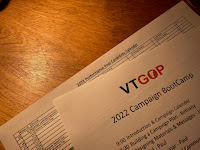Red Team Bootcamp
Saturday, I spent a day indoors in the least likely of places, the 2022 Campaign Bootcamp for Vermont Republicans at the Capitol Plaza Hotel in Montpelier. Everything about the Bootcamp was professional and polite, but there wasn't the ooze of money that one might expect in other parts of the country -- and few ties or jackets. I imagine the Democratic Party had a similar event, and probably with more people.
In a hotel conference room, the many PowerPoint-assisted presentations on the mechanics of campaigning provided a refresher on how to ask people to do something: who to ask; how to ask; when to ask; what to ask; where to ask; and when to stop asking.
There are clear similarities between the campaign techniques of this workshop and a VPIRG canvass: how to talk with people on the phone and in person. The window for productive canvassing is about 3 hours per day in the late afternoon, and weekdays are best. That's not a lot of time, so it needs to be used wisely. Bottom line: direct voter contact wins elections.
Voter identification, phone banking, and fundraising were covered extensively. I already know that I am going to skip these aspects of campaigning in the primary, but it was interesting to hear about the tools, WinRed and Numinar. The Democratic Party uses ActBlue to automate its fundraising. Phil Scott and the Progressives use Anedot.
In determining who to target during a campaign, voters are characterized in two dimensions; on one dimension, the likelihood that they will actually vote; on the other dimension, the likelihood that they would support 'our' candidate. Voters who are 'intermittent' -- as Pew Research calls them -- and persuadable are the voters who get the most attention.
Timing matters. Early in a campaign, it's message testing, then persuasion, and finally, getting out the vote (GOTV). This is why I say that Red Team and Blue Team are two sides of the same organization. At the core, they develop policies by talking to the same people, then regurgitate the issues as a dichotomies -- with an 'our' side and a 'their' side.
Third parties have a tough time taking off in American politics. Political scientist Lee Drutman of Fix Our House would like the legislative branch to be multi-party again and offers a quiz to classify New York Times readers into six proposed parties. Proportional representation is one way to get there. The Forward Party would like instant runoff voting and a single, open primary. There are many variations on those ideas. Vermonter Rick Hubbard will be walking across America to support reforming our democracy.
Fortunately, Vermont has had open party primaries for a very long time. Modest nomination thresholds also help make the field of candidates potentially much broader. Liam Madden and I are both in the Republican primary in order to participate in early campaigning and build support.
There are a lot of details that need to get sorted out in a few weeks of campaigning. I can see why parties would emerge as support services for candidates.
